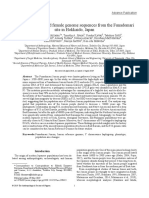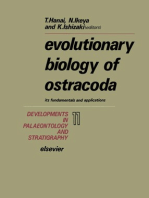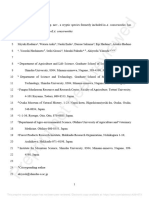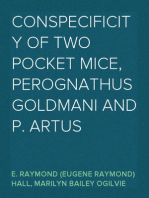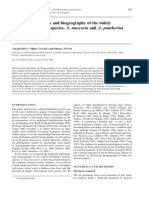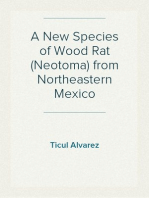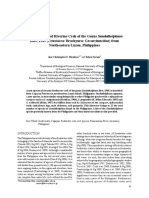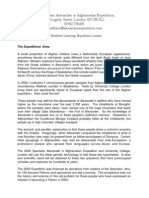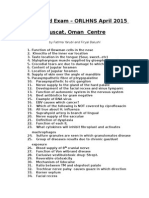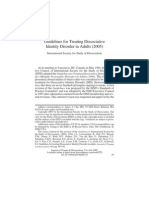Professional Documents
Culture Documents
Ief25 4 01
Uploaded by
Edward AndrèOriginal Title
Copyright
Available Formats
Share this document
Did you find this document useful?
Is this content inappropriate?
Report this DocumentCopyright:
Available Formats
Ief25 4 01
Uploaded by
Edward AndrèCopyright:
Available Formats
289
Ichthyol. Explor. Freshwaters, Vol. 25, No. 4, pp. 289-298, 6 figs., 1 tab., March 2015
© 2015 by Verlag Dr. Friedrich Pfeil, München, Germany – ISSN 0936-9902
Pseudorasbora pugnax,
a new species of minnow from Japan,
and redescription of P. pumila
(Teleostei: Cyprinidae)
Seigo Kawase*, ** and Kazumi Hosoya*
Pseudorasbora pugnax, new species, is described from the Ise Bay area in central Honshu, Japan. It is distinguished
from its Japanese congener P. pumila by the absence of a dark lateral stripe (vs. presence), 33-34 (vs. 34-35) ver-
tebrae, a comparatively more developed infraorbital canal of the cephalic lateralis system with a rostral branch
present (vs. absent), a nasal canal present (vs. absent) and mandibular canal complete (vs. incomplete). It is dis-
tinguished from the sympatric P. parva, by the longer head (27.5-31.9 % SL vs. 23.5-27.3), incomplete (vs. complete)
lateral line, and incomplete (vs. complete) infraorbital, supraorbital and supratemporal canals of the cephalic
lateralis. Pseudorasbora pumila is redescribed and a lectotype designated.
Introduction Japan and was previously considered to comprise
two subspecies, P. p. pumila and an undescribed
Species of Pseudorasbora Bleeker, 1860 are small subspecies (Nakamura, 1963, 1969). The two forms
cyprinid fishes widely distributed in East Asia are allopatric in Honshu Island, being found
from south-eastern Russia and Japan to northern north-east of the Fossa Magna (an important
Vietnam (Hosoya, 2013). Of the fourteen nominal geographical barrier for Japanese freshwater fish
taxa, four species are recognized as valid in recent fauna) and around the Ise Bay (the Tokai region
years: P. parva (Temminck & Schlegel, 1846), of central Honshu) area, respectively.
P. pumila Miyadi, 1930, P. elongata Wu, 1939 and Pseudorasbora pumila was originally described
P. interrupta Xiao, Lan & Chen, 2007. Pseudoras- by Miyadi (1930), based on eight specimens from
bora parva was originally distributed in East Asia the Shinai-numa Pond, Miyagi Prefecture, Japan.
from south-eastern Russia and west of Kanto It was believed at that time that this species was
region in Honshu, Japan to northern Vietnam and known only from northern Japan (north of the
is an invasive pest in Europe and Australia Fossa Magna). Later, Nakamura (1963) reported
(Bânârescu & Nalbant, 1973; Hosoya, 2013; Gozlan a population from the Ise Bay area, south-west
et al., 2010). Pseudorasbora pumila is endemic to of the Fossa Magna as “P. pumila subsp.”; it shares
* Graduate School of Agriculture, Kinki University, 3327-204, Nakamachi, Nara 631-8505, Japan.
** Lake Biwa Museum, 1091, Oroshimo, Kusatsu, Shiga 525-0001, Japan.
E-mail: kawauso0212@hotmail.co.jp, kawase@lbm.go.jp
Ichthyol. Explor. Freshwaters, Vol. 25, No. 4
290
Fig. 1. Pseudorasbora pugnax, KUN-P 43543, holotype, 59.7 mm SL, male; Japan: Gifu Prefecture: Mino.
the incomplete lateral line with P. p. pumila. This Naturhistorisch Museum, Leiden. Counts and
subspecies was distinguished from P. p. pumila measurements follow Hubbs & Lagler (2004). As
by the absence of a dark lateral band (vs. pres- the lateral line in both species under study is
ence). Since then, most Japanese ichthyologists incomplete, we included unpored scales in the
have tentatively recognized P. pumila subsp. as a total lateral-line scale count. Scales on the caudal
distinct, unnamed taxon (Nakamura, 1969; Kawa- fin were excluded from the lateral-line scale
nabe et al., 2001; Hosoya, 2013). counts. The last two rays of the dorsal and anal
Biological information necessary for taxo- fins were counted as one ray. Vertebral counts
nomic evaluation of the two forms in P. pumila followed Hosoya (1983); they were counted on
have been elucidated in previous studies, includ- radiographs and included the first four vertebrae
ing differences in chromosome morphology with the Weberian apparatus and one fused ver-
(Matsuda, 1988), allozymes (Konishi et al., 2003), tebra of the hypural complex. Observations of the
mitochondrial 16SrRNA (Watanabe et al., 2000) cephalic lateral line systems followed Fujita &
and cytochrome b (Watanabe & Mori, 2009) gene Hosoya (2005).
sequences, and on morphological characteristics
(Uchiyama, 1987). In addition, both forms are
geographically separated by the Fossa Magna. Pseudorasbora pugnax, new species
Taken together, these evidences indicate that the (Figs. 1, 2, 3a)
the two putative subspecies significantly differ
biologically. We thus describe the unnamed sub- Pseudorasbora pumila subsp.: Nakamura, 1963:
species of Japanese minnow as a new species, 125, pl. 52a-b; 1969: 181-185 (in part), pl. 53-
P. pugnax, and redescribe P. pumila in this study. 54, 117e-f; Kawamura & Hosoya, 1997: 57-60;
Kawanabe et al., 2001: 294, 308-309; Hosoya,
2002: 266, 2013: 322.
Material and methods Pseudorasbora parva pumila: Niwa, 1967: 116-118.
Specimens were fixed in 10 % formalin and pre- Holotype. KUN-P 43543, 59.7 mm SL, male; Ja-
served in 70 % ethanol. Material examined is in pan: Gifu: Mino: Ise Bay area, Nagara River
the following collections: FAKU, Department of system; K. Tsukahara; May 2011.
Fisheries, Faculty of Agriculture, Kyoto Univer-
sity, Kyoto; FRLM, Fisheries Research Labora- Paratypes. All from Ise Bay area, Japan. FRLM
tory, Mie University, Mie; KUN-P, Kinki Univer- 16286, 1, 48.7 mm SL; Mie: Watarai: Miya River
sity, Nara (earlier FAK); NSMT-P SK, National system; 25 Oct 1996. – GPM-Z 19302, 2, 43.1-
Science Museum, Tokyo; RMNH, National 50.1 mm SL; KUN-P 43544-43548, 5, 33.8-45.6 mm
Kawase & Hosoya: Pseudorasbora pugnax
291
b
Fig. 2. Pseudorasbora pugnax; a, KUN-P 43543, holotype, 59.7 mm SL, male; Japan: Gifu Prefecture: Mino (photo-
graph by Toshihiko Morimune); b, about 35 mm TL, female; Japan: Gifu Prefecture: Ogaki; aquarium specimen,
not preserved (photograph by Ryu Uchiyama).
SL; RMNH.PISC 37978, 1, 58.3 mm SL, male (fixed male and male; Gifu, Ogaki; M. Nakamura,
in 70 % ethanol); Gifu: Mino: Nagara River system; preserved 22 April 1955. – NSMT-P SK 2605, 2,
S. Kawase et al.; 20 June 2011 (fixed in 99.5 % 32.4-49.0 mm SL, female and male; Gifu: Ogaki:
ethanol). – GPM-Z 19303, 3, 26.0-27.3 mm SL; irrigation canal; M. Nakamura.
Gifu: Yoro: Yokoya, a pond on left bank of Tsuya
River; K. Hosoya, 31 July 1984. – KUN-P 43553- Non-types. KUN-P 43556, 20, 4-30.3 mm SL; same data
43555, 3, 44.9-46.3 mm SL; Aichi: Tsushima: as GPM-Z 19303. – KUN-P 44095-44096, 2, 50.8-59.5 mm
Tennou River; 16 June 1936. – KUN-P 44505, 1, SL (cleared and stained). – NSMT-P SK 521, 1, 29.4 mm
SL; Ogaki, Ezaki; M. Nakamura, 3 June 1949. – NSMT-
41.4 mm SL; MPM 1510-1511, 2, 40.9-46.0 mm
P SK 25674, 5, 40.7-55.0 mm SL; artificially bred indi-
SL; Mie: Ise; S. Mitani; 21 Nov 2013. – LBM viduals; M. Nakamura, fixed during the period between
1210054972-1210054973, 2, 46.0-46.7 mm SL, August and November 1966.
male, Mie: Ise; S. Kawase and S. Mitani; 18 Nov
2013. – NSMT-P SK 662, 2, 33.8-45.1 mm SL, fe-
Ichthyol. Explor. Freshwaters, Vol. 25, No. 4
292
Diagnosis. Pseudorasbora pugnax is distinguish- chin to isthmus curved, imparting convex appear-
able from other Japanese congeners by following ance to dorsal margin of head in lateral view.
characters; a faint dark stripe on the flank which Opercle posteriorly curved. Body relatively deep
disappears in females (Fig. 2b); poorly-developed and wide. Pectoral fin not reaching dorsal fin
nuptial tubercles in adult males. From P. parva it origin. Caudal fin forked; posterior tips of both
is distinguished by the following features: longer lobes rounded. Trunk lateral line incomplete.
head (27.5-31.9 % SL vs. 23.5-27.3), lateral line Infraorbital canal of cephalic lateralis system in-
incomplete (vs. complete), infraorbital, supraor- complete, not connected to supraorbital and
bital and supratemporal canals of the cephalic preopercle canals; rostral branch present; man-
lateralis system incomplete (vs. complete; see dibular canal not connecting preopercular canal;
Fig. 3). It is additionally distinguished from supratemporal canal not reaching lateral margins
P. pumila by the following characters: 33-34 ver- of head (Fig. 3).
tebrae (vs. 34-35), infraorbital canal of cephalic Dorsal fin with 3 simple and 7 branched rays.
lateralis system developed (vs. undeveloped) with Anal fin with 3 simple and 6 branched rays. Pec-
a rostral branch present (vs. absent), the nasal toral fin with 1 simple and 12-14 branched rays.
canal present (vs. absent) and mandibular canal Pelvic fin with 2 simple and 7 branched rays.
complete (vs. incomplete). Caudal fin with 1 simple, 9 + 6-9 branched and 1
simple principal rays. Pored lateral-line scales
Description. Morphometric data are shown in 0-6, followed by 27-33 unpored scales (total lat-
Table 1. Body small, elongate, rounded. Predorsal eral-line scales 31-33). Scale rows between later-
profile convex. Head large, depressed, relatively al-line scales and dorsal-fin origin 5-7; between
wide. Mouth superior, without barbels. Pharyn- lateral-line scales and anal-fin origin 4-5. Ab-
geal teeth in one row with dental formula 5-5. dominal vertebrae 18-19; caudal vertebrae 14-16;
Snout long. Eye moderately large, medially or total vertebrae 33-34. Dorsal proximal pterygio-
slightly dorsally positioned in head. Interorbital phores (including a terminal stay) 10-11; anal
distance wide. Cheek broad. Lateral profile from proximal pterygiophores 19-20.
Table 1. Measurements of holotype (male) and selected paratypes (n = 15) of Pseudorasbora pugnax, lectotype
(male) and paralectotypes (n = 5) of P. pumila and lectotype and paralectotype (n = 1) of P. parva. SD, standard
deviation. Values of holotype (H) and lectotype (L) included in ranges.
P. pugnax P. pumila P. parva
H range mean SD L range mean SD L paralecto-
type
Standard length (mm) 59.7 32.4-59.7 63.0 37.8-63.0 83.7 52.8
As percent of standard length
Head length 28.2 27.5-31.9 29.2 1.1 28.2 26.5-29.2 27.8 1.0 23.5 24.7
Body depth 27.9 25.3-31.5 28.1 2.0 31.3 27.5-32.0 30.0 1.8 27.0 28.6
Body width 17.2 16.0-20.0 17.5 1.5 17.4 15.6-17.9 16.8 0.9 11.4 11.4
Depth of caudal peduncle 14.3 11.2-15.3 13.4 1.1 15.1 12.2-15.9 14.3 1.4 12.5 12.9
Length of caudal peduncle 20.8 18.5-23.5 20.8 1.5 23.1 20.0-23.1 20.7 1.2 24.1 21.0
Preanal length 73.0 69.6-74.5 72.4 1.6 72.4 72.1-75.3 73.7 1.6 70.5 70.7
Prepelvic length 49.5 35.3-52.4 49.5 4.1 50.7 50.7-54.0 52.3 1.3 46.8 48.8
Height of dorsal fin 22.4 20.8-26.0 22.9 1.5 28.9 23.4-28.9 25.2 1.9 21.0 22.3
Length of dorsal fin base 13.2 12.7-15.9 13.7 1.0 16.1 13.1-17.5 15.1 1.7 11.8 13.1
Height of anal fin 15.3 11.4-17.5 15.4 1.6 17.9 15.9-20.1 17.2 1.6 15.4 13.9
Length of anal fin base 9.4 7.3-11.5 9.0 1.1 7.5 7.5-11.3 9.2 1.3 7.4 8.7
Pectoral fin length 18.4 15.2-21.3 17.5 1.6 18.3 13.2-18.3 16.0 2.2 17.8 17.8
Percent of head lengh
Head width 61 54-66 59.2 3.5 – – – – 59 48
Snout length 38 34-42 37.0 2.1 31 26-33 30.1 2.8 33 30
Orbit diameter 22 21-30 25.0 2.9 24 23-27 25.5 1.5 26 27
Interorbital width 47 32-49 41.7 4.3 48 40-49 44.5 4.1 43 40
Kawase & Hosoya: Pseudorasbora pugnax
293
TC
NC
LL
ST RB
SOC
POC
IOC MC
a
POC
3 mm
b
3 mm
c
3 mm
Fig. 3. Cephalic lateral line system of Japanese species of Pseudorasbora. a, P. pugnax; b, P. pumila; c, P. parva. IOC,
infraorbital canal; LL, lateral line; POC, preopercle canal; MC, mandibular canal; NC, nasal canal; RB, rostral
branch; SOC, supraorbital canal; ST, supratemporal canal; TC, temporal canal.
Coloration. In life, body and head brownish in Distribution and ecology. Pseudorasbora pugnax
female, grayish in male with silvery tinge, dark is known from Gifu, Aichi and Mie prefectures
dorsally and yellowish ventrally. Edge of each in central Japan (Fig. 4). Although the distribution
scale dark. Dorsal and caudal fin rays and mem- of this species is restricted to the Ise Bay area,
brane slightly brownish; other fin membranes there is some geographical variation. Three
almost clear. Lateral stripe absent or faint if pre- genotypes have been recognized (Ohnaka et al.,
sent. In preservative, specimens grayish dorsally, 1999). Morphologically, the Mie population is
pale yellowish and brown ventrally without sil- distinguished from the other populations of
very tinge. Grayish color provided by melanin P. pugnax by having a sharp snout, imparting a
on body and fins remains after fixation for a pug-headed appearance, and extremely swollen
relatively long period. humeral region (Kawamura & Hosoya, 1997;
Tamaoki et al., 1999). The species inhabits deep
Sexual dimorphism. Males develop secondary irrigation canals and ponds (1-2 m depth) with
sexual characteristics in breeding season emergent plant growth. The spawning season
(Figs. 1, 2): body larger than that of female; nup- extends from late March to early July and eggs
tial tubercles sparsely developed on snout and are preferentially laid under stones (< 200 cm3
lower jaw; dark grey nuptial color on all body volume) in shallow water (< 40 cm depth) (Kano
surfaces. Anterior margin of anal fin straight in et al., 2010).
males, slightly concave in females.
Ichthyol. Explor. Freshwaters, Vol. 25, No. 4
294
Remarks. Pseudorasbora pugnax is easily distin-
Japanese Archipelago
45°N
guishable from P. parva in having an incomplete
(vs. complete) lateral line. Two currently recog-
nized species of Pseudorasbora have an incomplete
lateral line: P. pumila and P. interrupta. Both
P. pugnax and P. pumila differ from P. interrupta
in the number of pored lateral line scales (0-6 vs.
Sea of Japan 40°N
7-15) (Xiao et al., 2007). It is more difficult to
distinguish between P. pugnax and P. pumila,
especially for individuals maintained in captivity
135°E for some time. However, in addition to the fea-
145°E
tures mentioned in the diagnosis, P. pugnax differs
130°E
35°N from P. pumila in the following characteristics:
dark lateral stripe absent (vs. present), number
of vertebrae 33-34 (vs. 34-35), infraorbital canal
of cephalic lateralis more developed, with longer
140°E supraorbital and infraorbital canals, rostral branch
of the infraorbital canal present (vs. absent), the
Pacific Ocean
nasal canal present (vs. absent) and the man-
Fig. 4. Distribution of Pseudorasbora pumila (green), dibular canal complete (vs. incomplete).
P. pugnax (blue) and P. parva (grey). Type locality of
P. pugnax indicated by a yellow star and of P. pumila by
a red square. Pseudorasbora pumila Miyadi, 1930
(Figs. 3b, 5, 6)
Conservation. Most natural habitats of P. pugnax
Pseudorasbora pumila: Miyadi, 1930: 445-448.
have been destroyed by human activities such as
Pseudorasbora parva pumila: Okada, 1960: 461-463.
urbanization, erosion of the “satoyama” landscape
Pseudorasbora pumila pumila: Nakamura, 1963: 126,
(which is a traditional Japanese rural land-use
plate 51a-b; 1969: 181-185 (in part), plate 117
system), and introduction of the alien invasive
(A-D); Bânârescu & Nalbant, 1973: 26-28 (in
predators Micropterus salmoides and Lepomis mi-
part); Kawanabe et al., 2001: 306-307; Hosoya,
croculus. Now wild populations are found in only
2002: 266, 2013: 322.
approximately 10 irrigation ponds. Therefore,
P. pugnax is currently categorized as critically Lectotype. FAKU-P 0178a, 63.0 mm SL, male;
endangered (IA) by the Ministry of the Environ- Japan: Miyagi: Shita: Shinai-Numa pond; 1916;
ment, Japan. In addition, the species is listed as D. Miyadi.
an endangered species by local governments and
designated as a protected species under the Law Paralectotypes. FAKU-P 0178b - f, 5, 37.8-
for the Conservation of Endangered Species of 51.3 mm SL; same data as lectotype.
Gifu, Aichi and Mie prefectures. To restore the
native habitat of P. pugnax, conservationists have Non-types. All from Japan. FAKU 51853-51856, 4,
been attempting to improve the environment and 44.1-58.5 mm SL; Yamagata, Sakata, Mogami River
re-introduce the minnow in the ponds (e. g. Mu- system, Yadare River; K. Hosoya. – FAKU 51857, 51859,
kai et al., 2011). 2, 56.2-71.3 mm SL, male; Akita, Yamamoto; Y. Kimi-
zuka, 7 May 1978. – FAKU 116478-116480, 3, 43.5-
47.4 mm SL; Nagano, Murayama; K. Hosoya, 24 April
Etymology. The specific epithet, pugnax, is Latin 1997. – KUN-P 43557-43561, 5, 39.4-42.3 mm SL; Na-
for ‘belligerent, aggressive, pugnacious’. Mature gano, Shinonoi; K. Hosoya, 24 April 1997.
males protect their territory very aggressively
during spawning season. Locally, this species is Diagnosis. Pseudorasbora pumila is distinguished
called ‘Kenka-Moroko’ (kenka means fighting in from the other of Pseudorasbora by the following
Japanese) (Niwa, 1967). Hence, the specific epithet combination of characters: head length 26.5-
well represents the behavioral characteristics of 31.6 % SL, lateral line incomplete, dark lateral
this species. stripe present in adults, 34-35 vertebrae and ce-
Kawase & Hosoya: Pseudorasbora pugnax
295
Fig. 5. Pseudorasbora pumila, FAKU-P 178-a, lectotype, 63.0 mm SL, male; Japan: Miyagi Prefecture: Shinai-numa
pond.
b
Fig. 6. Pseudorasbora pumila; Japan: Niigata Prefecture: Tokamachi; not preserved; a, male (spawning season),
about 50 mm TL; b, female, about 30 mm TL (photograph by Ryu Uchiyama).
Ichthyol. Explor. Freshwaters, Vol. 25, No. 4
296
phalic lateral line systems undeveloped: infraor- depigmentation because of long-term preserva-
bital canal incomplete, rostral branch almost tion, as in lectotype.
absent, nasal canal (anteriormost part of supraor-
bital canal) absent and mandibular canal incom- Sexual dimorphism. Males develop secondary
plete. sexual characteristics in breeding season: body
larger than that of female; nuptial tubercles de-
Description. Morphometric data are shown in veloping on snout and lower jaws; dark grey
Table 1. Body small, elongate, rather rounded. nuptial color on all body surfaces. Lateral stripe
Predorsal profile straight. Head longer, depressed, disappearing in males during the spawning sea-
relatively wide. Mouth superior; no barbels. son.
Pharyngeal teeth in one row, 5-5. Snout somewhat
long. Eye moderately large, medially or slightly Distribution and ecology. Pseudorasbora pumila
high dorsally positioned in head. Interorbital is distributed in the Honshu Island, north-east of
space wide. Cheek somewhat broad. Lateral the Fossa Magna from Nagano to Aomori prefec-
profile from chin to isthmus curved, imparting tures (Fig. 4). It shows significant genetic differ-
convex appearance to dorsal margin of head. entiation between populations of the Ohu Moun-
Opercle posteriorly curved. Body relatively deep, tain range on the Sea of Japan slope and the Pa-
and relatively wide. Dorsal-fin origin located cific slope (Hanzawa, pers. comm.). It inhabits
midway along SL. Pectoral fin not reaching irrigation canals and ponds with muddy or
dorsal-fin origin. Pelvic-fin origin slightly ante- sandy/muddy bottoms. The spawning season
rior to dorsal-fin origin. Posterior margin of extends from April to July.
caudal fin forked; posterior tips of both lobes of
caudal fin rounded. Infraorbital canal of cephal- Conservation. Wild populations of P. pumila are
ic lateralis system incomplete, not connecting facing extinction by hybridization with domestic
supraorbital and preopercle canal; rostral branch invasive P. parva and predation by alien species
absent; mandibular canal incomplete, not con- such as M. salmoides. Now, P. pumila is listed as
necting preopercular canal; supratemporal canal an endangered species by the Ministry of the
not reaching lateral margins of head (Fig. 3). Environment, Japan and many local governments.
Dorsal fin with 3 simple and 7 branched rays. In addition, P. pumila is designated as a protected
Anal fin with 3 simple and 6 branched rays. Pec- species by Nagano Prefecture and by Aomori City
toral fin with 1 simple and 10-13 branched rays. (Matahachinuma-pond).
Pelvic fin with 2 simple and 7 branched rays.
Caudal fin with 1 simple, 9 + 8 branched and 1 Remarks. Miyadi (1930) briefly described P. pu-
simple principal rays. Pored lateral-line scales mila on the basis of eight specimens without
3-4, followed by 29-32 unpored scales (total designating a holotype. Among them, six syntypes
lateral-line scales 34-35). Scale rows between are deposited in FAKU. The other two syntypes
lateral-line scales and dorsal-fin origin 5-7; be- are probably lost. We designate FAKU 0178a as
tween lateral-line scales and anal-fin origin 4-6. lectotype; it is the largest male and presents the
Abdominal vertebrae 20-22; caudal vertebrae characteristics of the species.
13-15; total vertebrae 34-35. Dorsal proximal Pseudorasbora pumila uchidai is known from
pterygiophores (including terminal stay) 11-12; the Ise Bay area. Its range partially overlaps with
anal proximal pterygiophores 20-21. that of P. pugnax. Pseudorasbora pumila uchidai was
originally described as Pseudorasbora parva uchi-
Coloration. In life, body silvery brown in female, dai by Okada & Kubota (1957) based on specimens
greyish in male, darker dorsally and yellowish collected in Mie Prefecture, Japan. Subsequently,
ventrally, with a black lateral stripe. Edge of each P. parva uchidai was treated as a subspecies of
scale dark. Dorsal and caudal-fin rays and mem- P. pumila by Nakamura (1963; 1969) because they
branes slightly brownish, other fin membranes share an incomplete lateral line. Although
almost clear. In preservative, specimens grayish Bânârescu & Nalbant (1973) agreed with Naka-
dorsally, pale yellowish and brown ventrally, mura’s opinion, they suggested that P. pumila
without silvery tinge. Remaining after fixation, a pumila and P. pumila uchidai may have originated
black lateral stripe gradually disappearing by independently from distinct populations of P. par-
Kawase & Hosoya: Pseudorasbora pugnax
297
va because P. pumila uchidai has more pored lat- Gozlan, E. R., D. Andreou, T. Asaeda, K. Beyer, R.
eral line scales (at least 15 vs. 0-6) and a more Bouhadad, D. Burnard, N. Caiola, P. Vakic, V.
slender body (depth 19.3-21.9 % SL vs. 27.5-32.0) Djikanovic, H. R. Esmaeili, I. Falka, D. Golicher, A.
Harka, G. Jeney, V. Kovac, J. Musil, A. Nocita, M.
than P. pumila pumila. Hosoya (2013) treated
Povz, N. Poulet, T. Virbickas, C. Wolter, A. S. Tar-
P. parva uchidai as a geographic variant of P. par- kan, E. Tricarico, T. Trichkova, H. Verreycken, A.
va because individuals of P. parva with an incom- Witkowki, C. G. Zhang, I. Zweimueller & J. R.
plete lateral line are occasionally encountered and Britton. 2010. Pan-continental invasion of Pseudo-
because there are many geographic variants of rasbora parva: towards a better understanding of
P. parva. freshwater fish invasions. Fish and Fisheries, 11:
315-340.
Comparative materials. All from Japan. Pseudorasbora Hosoya, K. 1983. Geographic variation of number of
parva: RMNH 2634, 1, lectotype, 83.7 mm SL; RMNH vertebrae in Squalidus. The Freshwater Fishes, 9:
2638, 1, paralectotype, 52.8 mm SL. – FAK 15260, 15263, 43-48. [In Japanese].
15265, 3, 51.3-60.4 mm SL, female and males; Osaka: — 2002. Cyprinidae. Pp. 253-272 in: T. Nakabo (ed.),
Hattori River. – KUN-P 41740, 1, 66.4 mm SL, male; Fishes of Japan with pictoral keys to the species.
Fukuoka: Yanagawa: Futatsu River. – KUN-P 41756- English edition. Tokai University Press, Tokyo.
41757, 2, 59.1-63.3 mm SL, male; Saga: Ogi. – KUN-P — 2013. Cyprinidae. Pp. 308-327, 1813-1819 in: T.
43793, 1, 61.4 mm SL, female; Kyoto: Koga Irrigation. Nakabo (ed.), Fishes of Japan with pictoral keys to
– KUN-P 43795-43798, 4, 37.4-52.1 mm SL; Kyoto: Koga the species, third edition. Tokai University Press,
irrigation. – KUN-P 43800-43802, 3, 63.7-75.9 mm SL; Tokyo. [In Japanese].
Nara: Tawaramoto. – KUN-P 43817, 1, 66.2 mm SL, Hubbs, C. L. & K. F. Lagler. 2004. Fishes of the Great
male; Osaka: Akagawa wando-pool of Yodo River. – Lakes region. Revised edition. University of Mich-
KUN-P 43820-43823, 1, 50.5 mm SL, male; Kyoto: Seika: igan Press, Bloomfield Hills, xxxii + 276 pp.
Kizu River. Kano, Y., J. Kitamura & K. Kawamura. 2010. [Spawning
ecology and schemes for the conservation of an
endangered cyprinid, Psudorasbora pumila subsp.
Acknowledgments sensu Nakamura (1969), including comparisons
with a related species, Pseudorasbora parva]. Japanese
We greatly appreciate Takahiko Mukai (Gifu Univer- Journal of Ichthyology, 57: 43-57. [In Japanese].
sity), Koji Tsukahara, Yoshiaki Miwa (Gifu Mino Eco- Kawamura, K. & K. Hosoya. 1997. [Discovery of an
logical Research Group), Shinya Mitani (Toba Aquari- endangered cyprinid, Pseudorasbora pumila subsp.
um) and Jun-ichi Kitamura (Mie Prefectural Museum) sensu Nakamura (1969), from the Miya River Sys-
for collecting the specimens of P. pugnax, Kiyotaka tem, Mie]. Japanese Journal of Ichthyology, 44:
Takahashi (Conservation Society of Shinaimotsugo) and 57-60. [In Japanese, English abstract].
Kouichi Kawamura (Mie University) for their help and Kawanabe, H., N. Mizuno & K. Hosoya. 2001. [Fresh-
advice, and Naoto Hanzawa (Yamagata University) for water fishes of Japan]. Yama-Kei, Tokyo, 719 pp.
providing helpful genetic information. We sincerely [In Japanese].
thank Tetsuji Nakabo (FAKU), M. J. P. Van Oijen, R. de Konishi, M., K. Hosoya & K. Takata. 2003. Natural
Ruiter (RMNH), Keiichi Matsuura, Gento Shinohara hybridization between endangered and introduced
(NSMT) and Masanari Matsuda (LBM) for observations species of Pseudorasbora, with their genetic relation-
or loan of material under their care, Ryu Uchiyama ships and characteristics inferred from allozyme
(nature photographer) and Toshihiko Morimune (KUN) analyses. Journal of Fish Biology, 63: 213-231.
for photographs of live specimens. Part of this study Matsuda, M. 1988. [Chromosome of Pseudorasbora
was financially supported by a Grant-in-Aid for JSPS pumila subsp.]. The annual reports of the Biwako
Fellows (no. 24-4703 for S. Kawase). Bunkakan, 6: 31-33. [In Japanese].
Miyadi, D. 1930. Notes on a new cyprinoid fish, Pseudo-
rasbora pumila, sp. nov. from Sinai-numa, prov.
Rikuzen. The Zoological Society of Japan, 12: 445-
Literature cited
448.
Mukai, T., K. Tsukahara & Y. Miwa. 2011. The re-intro-
Bânârescu, P. & T. T. Nalbant. 1973. Pisces, Teleostei,
duction of the Ushimotsugo minnow in Gifu Pre-
Cyprinidae (Gobioninae). Das Tierreich, 93: i-vii,
fecture, Japan. Pp. 54-58 in: P. S. Soorae (ed.),
1-304.
Global re-introduction perspectives: 2011. More case
Bleeker, P. 1860. Ichthyologiae archipelagi indici pro-
studies from around the globe. IUCN/SSC Re-in-
dromus. Vol. II. Cyprini. Lange, Batavia, xiv + 492 pp.
troduction Specialist Group, Gland & Environment
Fujita T. & K. Hosoya. 2005. Cephalic lateral line systems
Agency, Abu Dhabi.
in the Far Eastern species of the genus Phoxinus
(Cyprinidae). Ichthyological Research, 52: 336-342.
Ichthyol. Explor. Freshwaters, Vol. 25, No. 4
298
Nakamura, M. 1963. [Keys to the freshwater fishes of lustravit P. F. de Siebold conjunctis studiis C. J.
Japan fully illustrated in colors]. Hokuryukan, Temminck et H. Schlegel pro vertebratis atque W.
Tokyo, 258 pp. [In Japanese]. de Haan pro invertebratis elaborata. Lugdunum
— 1969. [Cyprinid fishes of Japan]. Research Institute Batavorum [Leiden], 324 pp., 161 pls.
for Natural Resources, Tokyo, viii + iv + 455 pp., Uchiyama, R. 1987. [Morphology and ecology of Pseu-
149 pls. [In Japanese]. dorasbora pumila subsp.]. Freshwater Fish, 13: 74-84.
Niwa, H. 1967. [Fish of Kiso River]. Taishushobou, Gifu, [In Japanese].
293 pp. [In Japanese]. Watanabe, K. 1998. Parsimony analysis of the distribu-
Ohnaka, T., H. Sasaki, K. Nagai & K. Numachi. 1999. tion pattern of Japanese primary freshwater fishes,
[Marked monomorphism at the D-loop region of and its application to the distribution of the bagrid
mtDNA in an endangered species Pseudorasbora catfishes. Ichthyological Research, 45: 259-270.
pumila subsp. sensu Nakaamura (1963)]. Nippon — 2012. Faunal structure of Japanese freshwater
Suisan Gakkaishi, 65: 1005-1009. [In Japanese]. fishes and its artificial disturbance. Environmental
Okada, Y. 1960. Studies on the freshwater fishes of Japan. Biology of Fishes, 94: 533-547.
Journal of Faculty for Fisheries Prefectural Univer- Watanabe, K., K. Iguchi, K. Hosoya & M. Nishida. 2000.
sity of Mie, 4: 267-890. Phylogenetic relationships of the Japanese minnows,
Okada, Y. & S. S. Kubota. 1957. A new cyprinoid fish, Pseudorasbora (Cyprinidae), as inferred from mito-
Pseudorasbora parva uchidai, sub-sp. nov. found in chondrial 16SrRNA gene sequences. Ichthyological
Japan. Journal of the Faculty of Science, Hokkaido Research, 47: 43-50.
University, Series 6, Zoology, 13 (1-4): 99-100. Watanabe, K & S. Mori. 2009. Comparison of genetic
Tamaoki, F., S. Mitani, G. Kamioka, M. Furuta & K. population structure between two cyprinids, Hemi-
Kawamura. 1999. [Discovery of an endangered grammocypris rasborella and Pseudorasbora pumila
cyprinid, Pseudorasbora pumila subsp. sensu Naka- subsp., in the Ise Bay basin, central Honshu, Japan.
mura (1969) from Ise (Isuzu River system)]. An- Ichthyological Research, 55: 309-320.
nual Report of Toba Aquarium, 10: 33-39. [In Japa- Wu, H.W. 1939. On the fishes of Li-Kiang. Sinensia, 10:
nese, English abstract]. 92-142.
Temminck, C. J. & H. Schlegel. 1842-1850. Pisces. In: Xiao, Z., Z. H. Lan & X. L. Chen. 2007. A new species
Fauna japonica, sive descriptio animalium quae in of the genus Pseudorasbora from Guangdong prov-
itinere per Japoniam suscepto annis 1823-30 col- ince, China (Cypriniformes, Cyprinidae). Acta
legit, notis observationibus et adumbrationibus il- Zootaxonomica Sinica, 32: 977-980.
Received 21 October 2013
Revised 28 September 2014
Accepted 15 February 2015
Kawase & Hosoya: Pseudorasbora pugnax
You might also like
- Materials For The Distribution of Lichens in Japan (16) Usnea Filipendula StirtDocument3 pagesMaterials For The Distribution of Lichens in Japan (16) Usnea Filipendula Stirtanca irinaNo ratings yet
- Komatasu Et Al 2021 Periplaneta Gajajimana SP Nov From JapanDocument5 pagesKomatasu Et Al 2021 Periplaneta Gajajimana SP Nov From JapanDávid RédeiNo ratings yet
- Systematic Review of Japanese Macaques Macaca Fuscata Gray 1870 2006Document198 pagesSystematic Review of Japanese Macaques Macaca Fuscata Gray 1870 2006yo soy mutNo ratings yet
- Yoshino 2006Document7 pagesYoshino 2006Renz DucoNo ratings yet
- Late Jomon Male and Female Genome Sequences From The Funadomari Site in Hokkaido, JapanDocument26 pagesLate Jomon Male and Female Genome Sequences From The Funadomari Site in Hokkaido, JapanTomNo ratings yet
- Taxonomic Study of Psyllids Reveals Four New Endemic Species in the Ogasawara IslandsDocument17 pagesTaxonomic Study of Psyllids Reveals Four New Endemic Species in the Ogasawara IslandsJim VillenaNo ratings yet
- Identifying Mud Crab Species Using Genetics and MorphologyDocument6 pagesIdentifying Mud Crab Species Using Genetics and MorphologyHitendra Nath BarmmaNo ratings yet
- Watanabe Etal 2013 Neurothemislarva Tombo 55Document5 pagesWatanabe Etal 2013 Neurothemislarva Tombo 55Fahmi RomadhonNo ratings yet
- Arimoto - MacGowan - Su - 2020 - Lonchaeidae Asociadas A Higo - JaponDocument7 pagesArimoto - MacGowan - Su - 2020 - Lonchaeidae Asociadas A Higo - Japonangel juarezNo ratings yet
- Taxonomy and Molecular Phylogeny of Usnea Rubicunda And: U. Rubrotincta (Parmeliaceae, Lichenized Ascomycotina)Document9 pagesTaxonomy and Molecular Phylogeny of Usnea Rubicunda And: U. Rubrotincta (Parmeliaceae, Lichenized Ascomycotina)anca irinaNo ratings yet
- Katayama Et Al. - 2012 - A New Species of Trichonotus From SomaliaDocument13 pagesKatayama Et Al. - 2012 - A New Species of Trichonotus From SomaliaMuntasir AkashNo ratings yet
- Belokobylskij 2008 Ryukyuspathius Gen NovDocument7 pagesBelokobylskij 2008 Ryukyuspathius Gen NovDávid RédeiNo ratings yet
- Maculophis Bellus ChapaensisDocument14 pagesMaculophis Bellus ChapaensisHạt Vừng LépNo ratings yet
- Evolutionary Biology of Ostracoda: Its Fundamentals and ApplicationsFrom EverandEvolutionary Biology of Ostracoda: Its Fundamentals and ApplicationsNo ratings yet
- BNSM A310102Document14 pagesBNSM A310102Yayan MardiansyahNo ratings yet
- Canuellidae (Copepoda, Harpacticoida) From The Bohai Sea, ChinaDocument37 pagesCanuellidae (Copepoda, Harpacticoida) From The Bohai Sea, ChinapcorgoNo ratings yet
- 53 KJ00006420137Document8 pages53 KJ00006420137NindzRMapeNo ratings yet
- ZR 2023 32 1 YakovlevDocument5 pagesZR 2023 32 1 YakovlevNindzRMapeNo ratings yet
- Om Southern Coastal Watersin Koreaand JapanDocument19 pagesOm Southern Coastal Watersin Koreaand JapanRenZo Rivera LujanNo ratings yet
- Japanese Pylopαguropsis Species ReviewedDocument39 pagesJapanese Pylopαguropsis Species ReviewedKA CHAI CheungNo ratings yet
- Five new ciliate records from South KoreaDocument6 pagesFive new ciliate records from South KoreaAntonela HerreraNo ratings yet
- Title: Instructions For UseDocument4 pagesTitle: Instructions For Usezakiah syifaNo ratings yet
- Ief25 4 07Document10 pagesIef25 4 07Edward AndrèNo ratings yet
- Amanita Satotamagotake Sp. Nov., a Cryptic Species Formerly Included In A. Caesareoides, Has Invaded the Natural Habitat Of A. CaesareoidesDocument34 pagesAmanita Satotamagotake Sp. Nov., a Cryptic Species Formerly Included In A. Caesareoides, Has Invaded the Natural Habitat Of A. CaesareoidesasaaguurNo ratings yet
- Spatial Distributions of Phyllosoma Larvae (Crustacea: Decapoda: Palinuridae and Scyllaridae) in Taiwanese WatersDocument14 pagesSpatial Distributions of Phyllosoma Larvae (Crustacea: Decapoda: Palinuridae and Scyllaridae) in Taiwanese WatersRezkina AmaliaNo ratings yet
- Hiroaki-1994-Bradybatus (Bradybatus) SharpiDocument41 pagesHiroaki-1994-Bradybatus (Bradybatus) Sharpihy981204No ratings yet
- Watanabe 1934 Sauters FormosaAusbeute BraconidaeDocument25 pagesWatanabe 1934 Sauters FormosaAusbeute BraconidaeDávid RédeiNo ratings yet
- A Revision of The Akysid Catfish Genus Breitensteinia Steindachner With Descriptions of Two New SpeciesDocument13 pagesA Revision of The Akysid Catfish Genus Breitensteinia Steindachner With Descriptions of Two New SpeciesafifatoniNo ratings yet
- Fissurellidae in JapanDocument20 pagesFissurellidae in JapanMarc AlexandreNo ratings yet
- Conspecificity of two pocket mice, Perognathus goldmani and P. artusFrom EverandConspecificity of two pocket mice, Perognathus goldmani and P. artusNo ratings yet
- Ueng 2013 Two Ochthera From TaiwanDocument7 pagesUeng 2013 Two Ochthera From TaiwanDávid RédeiNo ratings yet
- oda 2004. Amanita.Document12 pagesoda 2004. Amanita.IsatoTVNo ratings yet
- 252 1329 1 PBDocument29 pages252 1329 1 PBAlison CalderónNo ratings yet
- Descriptions of Two Species of Frogs, Genus Ptychohyla Studies of American Hylid Frogs, VFrom EverandDescriptions of Two Species of Frogs, Genus Ptychohyla Studies of American Hylid Frogs, VNo ratings yet
- Ambiguities in the identification of batoid lateral line systems clarified by innervationDocument4 pagesAmbiguities in the identification of batoid lateral line systems clarified by innervationKarina SjNo ratings yet
- Mizukobo 1981 Blattella of Japan IDocument11 pagesMizukobo 1981 Blattella of Japan IDávid RédeiNo ratings yet
- A New Species of Monodelphis (Didelphimorphia: Didelphidae) From Southeastern PeruDocument8 pagesA New Species of Monodelphis (Didelphimorphia: Didelphidae) From Southeastern PeruJulio César Chávez GalarzaNo ratings yet
- The Nature of the Beasts: Empire and Exhibition at the Tokyo Imperial ZooFrom EverandThe Nature of the Beasts: Empire and Exhibition at the Tokyo Imperial ZooNo ratings yet
- Yoshihito O and Kwang-Hee M: Materials For The DistributionDocument2 pagesYoshihito O and Kwang-Hee M: Materials For The Distributionanca irinaNo ratings yet
- PholidobolusDocument8 pagesPholidobolusAnahí EsquivelNo ratings yet
- Sasakawa 1955 Nocticanace Pacificus SP Nov From TaiwanDocument4 pagesSasakawa 1955 Nocticanace Pacificus SP Nov From TaiwanDávid RédeiNo ratings yet
- Marshal and Thornton 1963. MICROMALTHUS (Coleoptera - Micromalthidae) in Hong KongDocument6 pagesMarshal and Thornton 1963. MICROMALTHUS (Coleoptera - Micromalthidae) in Hong KongCarlos AguilarNo ratings yet
- Senoh 1984 Notioxenus Deropygoides SP Nov From TaiwanDocument4 pagesSenoh 1984 Notioxenus Deropygoides SP Nov From TaiwanDávid RédeiNo ratings yet
- An Anthropology of Ba: Place and Performance Co-emergingFrom EverandAn Anthropology of Ba: Place and Performance Co-emergingNo ratings yet
- 79989-Article Text-291227-319115-10-20230104Document9 pages79989-Article Text-291227-319115-10-20230104sharktank4youNo ratings yet
- Ogino 2008 New Middle Pleistocene Galictini (Mustelidae, Carnivora)Document9 pagesOgino 2008 New Middle Pleistocene Galictini (Mustelidae, Carnivora)Ghaier KazmiNo ratings yet
- Morphological Evidence For The Taxonomic Status of The Bridge's Guan, (Aves: Cracidae)Document10 pagesMorphological Evidence For The Taxonomic Status of The Bridge's Guan, (Aves: Cracidae)Diego Evangelista VargasNo ratings yet
- 96 Arbea&Park 2015 Deuteraphorura KoreaDocument5 pages96 Arbea&Park 2015 Deuteraphorura KoreajarbeapoNo ratings yet
- Gender Gymnastics: Performing and Consuming Japan's Takarazuka RevueFrom EverandGender Gymnastics: Performing and Consuming Japan's Takarazuka RevueRating: 3.5 out of 5 stars3.5/5 (1)
- 2013 Lourenço-De-Moraes Et Al. Girino e Canto Aparasphenodon ArapapaDocument5 pages2013 Lourenço-De-Moraes Et Al. Girino e Canto Aparasphenodon ArapapaamandasantiagoNo ratings yet
- Unusual Looking Pentatomids: Reassessing The Taxonomy of Braunus Distant and Lojus McDonald (Hemiptera: Heteroptera: Pentatomidae)Document19 pagesUnusual Looking Pentatomids: Reassessing The Taxonomy of Braunus Distant and Lojus McDonald (Hemiptera: Heteroptera: Pentatomidae)bolosphex1634No ratings yet
- Elephant Dung - EcosystemDocument2 pagesElephant Dung - EcosystemmeshikaNo ratings yet
- A Synopsis of The Parasites From Cyprinid Fishes of The Genus Tribolodon in Japan (1908-2013)Document31 pagesA Synopsis of The Parasites From Cyprinid Fishes of The Genus Tribolodon in Japan (1908-2013)Mirela CrețuNo ratings yet
- A New Supspecies of Slider Turtle (Pseudemys scripta) from Coahuila, MexicoFrom EverandA New Supspecies of Slider Turtle (Pseudemys scripta) from Coahuila, MexicoNo ratings yet
- Labeo Filiferus PDFDocument6 pagesLabeo Filiferus PDFSubhadra LaimayumNo ratings yet
- Copepoda Mesocyclops Ogunnus Matsumura e Silva 2002Document6 pagesCopepoda Mesocyclops Ogunnus Matsumura e Silva 2002Higor LessaNo ratings yet
- New species of river crab from LuzonDocument10 pagesNew species of river crab from LuzonNel YagosNo ratings yet
- P. Pirarara - Chamon & Sousa, 2016Document14 pagesP. Pirarara - Chamon & Sousa, 2016CarineChamonNo ratings yet
- Proteins Amino Acids: Frederick A. Bettelheim William H. Brown Mary K. Campbell Shawn O. FarrellDocument12 pagesProteins Amino Acids: Frederick A. Bettelheim William H. Brown Mary K. Campbell Shawn O. FarrellAdelaTeresaNo ratings yet
- The Spectator Alexander in Afghanistan Project - Matthew LeemingDocument9 pagesThe Spectator Alexander in Afghanistan Project - Matthew LeemingMarsyas PeriandrouNo ratings yet
- Wound ManagementDocument86 pagesWound ManagementRăzvanAndrei67% (3)
- Taqpath Proamp Master Mixes: Quick ReferenceDocument2 pagesTaqpath Proamp Master Mixes: Quick ReferenceFabio RossiNo ratings yet
- Competency Analysis ReportDocument9 pagesCompetency Analysis ReportMangligot JeffreyNo ratings yet
- Understanding the spiral progression of elementary science curriculumDocument4 pagesUnderstanding the spiral progression of elementary science curriculumEvelyn ReantasoNo ratings yet
- Kltdensito2 PDFDocument6 pagesKltdensito2 PDFPutuWijayaKusumaNo ratings yet
- Part - 1 - Circulatory - System - 1.ppt Biology 2Document11 pagesPart - 1 - Circulatory - System - 1.ppt Biology 2RekaNo ratings yet
- The Naming of The Cranial Nerves - A Historical ReviewDocument7 pagesThe Naming of The Cranial Nerves - A Historical ReviewAfnan SefffNo ratings yet
- Pilot Study On Antardhuma Rasasindura A Forgotten AmbrosiaDocument8 pagesPilot Study On Antardhuma Rasasindura A Forgotten AmbrosiaKrasimir GeorgievNo ratings yet
- Nervous System Class 10Document35 pagesNervous System Class 10Just JaenNo ratings yet
- Cost Effective Submarine Electrophoresis ApparatusDocument3 pagesCost Effective Submarine Electrophoresis ApparatusRanadive AnanthNo ratings yet
- SWSC2 - Learning Outcome 1Document9 pagesSWSC2 - Learning Outcome 1Marcela Coid100% (2)
- Gibberelic Acid Regist. - Core GIBBER - 9-Section - 8Document5 pagesGibberelic Acid Regist. - Core GIBBER - 9-Section - 8Fered KhaliliNo ratings yet
- Food Web InterpretationDocument3 pagesFood Web InterpretationanaNo ratings yet
- Arab Board Exam April 2015Document3 pagesArab Board Exam April 2015Firyal Balushi50% (4)
- Activity 2 OogenesisDocument7 pagesActivity 2 OogenesisHILARY PARAGAS. CORUÑANo ratings yet
- Basic Laboratory Equipment and Procedures in The Study of BacteriaDocument10 pagesBasic Laboratory Equipment and Procedures in The Study of BacteriaLloyd LozanoNo ratings yet
- Patient Register of Wira Sakti ClinicDocument73 pagesPatient Register of Wira Sakti ClinicAldy SetyawanNo ratings yet
- Life Science CompilationDocument43 pagesLife Science CompilationAmandaNo ratings yet
- Dissociative Disorder - Treatment GuidelinesDocument81 pagesDissociative Disorder - Treatment Guidelinesdvladas100% (1)
- BS 8496Document24 pagesBS 8496Calidad NavecoNo ratings yet
- Corticosteroids Regulation and Clinical UsesDocument36 pagesCorticosteroids Regulation and Clinical UsesAbdur RafayNo ratings yet
- Psych Final Exam ReviewerDocument49 pagesPsych Final Exam ReviewerDAVID BAYANI AGCAOILINo ratings yet
- Specimen QP - Paper 3 OCR Biology (A) A-LevelDocument20 pagesSpecimen QP - Paper 3 OCR Biology (A) A-LevelAbir OmarNo ratings yet
- Microbial InsecticidesDocument29 pagesMicrobial InsecticidesChandni V. AhujaNo ratings yet
- Mechanism of TranspositionDocument16 pagesMechanism of TranspositionBandook Gamers100% (2)
- AP Biology final exam revision guideDocument20 pagesAP Biology final exam revision guidealiNo ratings yet
- Friday 24 May 2019: Biology BDocument24 pagesFriday 24 May 2019: Biology BAyaNo ratings yet
- Skema-Amali - Peperiksaan Akhir Semester 1 Tingkatan 4Document4 pagesSkema-Amali - Peperiksaan Akhir Semester 1 Tingkatan 4Khaw Poh HwaNo ratings yet





